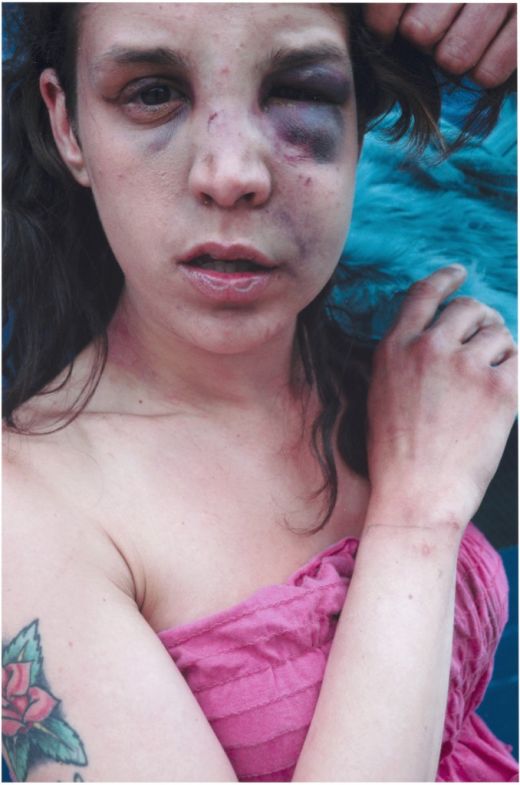
Zoe Strauss Monique Showing Black Eye, 2001-2008. Ink jet print, 81/2 x 11 inches. Photo credit: Sid Hoeltzell.
The tumble of first impressions went something like this: Street photographs. Striking colors. Not that large. In-your-face portraits—faces that looked as worn-out as old rugs, others full of confidence and a beauty rendered more intense by the way that what they were confident of was that the beauty wouldn’t last, so that the confidence too was touched by resignation. (A close-up version of this same emotion was of a navel piercing that looked so inflamed it was well on the way to becoming infected.) Signs and graffiti, the never-ending dialogue between the multiple promises of wealth, cash—‘CASINO’—and redemption—‘SAVE’—and the guarantee that they’ll be broken. A sign offering ‘EVERYTHING’ ends up getting reduced to ‘- – ER-TH- – G’. Better than nothing? Maybe, but it’s not as emphatic as the message sprayed on a wall: ‘IF YOU READING THIS FUCK YOU’. Scattered among this richly (in the sense of poorly) peopled and much-written-upon social landscape are oases of pure angles and lines: impeccable grids of concrete and windows. These almost always contain some detail—a crack in the concrete, a boarded-up window—to refute the utopian claims of abstraction. But not always always: a carpet climbing the stairs in Las Vegas forms horizontal bands of color so lush and textured they look like manicured red hedges.

Zoe Strauss, Mattress Flip, 2001-2008. Ink jet print. 8-1/2 x 11 inches. Photo: Sid Hoeltzell
It’s obvious, to anyone who visits this show that Strauss is an artist with a distinctive visual style; and it’s equally obvious that this distinction is impossible to separate from the way that so many threads of American photographic history seem to have found their way into the tightly bound forms of her pictures. The tattooed girl—Monique—with a beaten face and a black eye recalls a self-portrait made by Nan Goldin after she’d been battered. There’s a lot of Eggleston—most notably a green version of his famous red ceiling—and a lot of Stephen Shore too. And there are traces of Walker Evans—how could there not be?—everywhere. No sooner have these influences—or presences—been registered, however, than one becomes conscious of how Strauss’s relationship to photography and to the world adds to or alters them. She never simply ‘does’ an Evans or an Eggleston. Take Goldin, for example. The pictures in The Ballad of Sexual Dependency are frank, intimate, beautiful and profoundly narcissistic. They are advertisements for a life being led: a bohemia that was longing to be recognised, a bunch of people whose poverty was a form of indulgence, who believed they were artists—even if there was no chance of their ever creating works of art. Except they were justified in their belief after all because they ended up in works of art, in Nan’s pictures. It’s a very different world here in Strauss’s Philadelphia, where the poverty is as matter-of-fact as it is in an Evans photograph of rural Alabama. The difference—from Evans—is that Strauss is not an outsider, is as intimate with the facts as Nan was with her fictions. And Strauss didn’t have to insinuate herself into situations as Diane Arbus did; she was already there, in the midst of the lives depicted. By the time she began ranging further afield—in Vegas, say—she was able to take this home-grown familiarity and confidence with her. As she puts it, rather beautifully, in a Facebook exchange with a friend (included in the catalogue for the Philadelphia/ICP exhibition): “I just always let everything in and keep everyone who’s ever mattered as a part of myself.” To which the friend replies, rightly: “Wow… That is a phenomenal outlook on life.”
The traces and precedents running through Strauss’s photographic outlook are mainly American—but not exclusively so. There are some pictures—of a Blue Building with Grass, near Limerick, PA, or of city lights at night—which, if they were blown up bigger, could be mistaken for Gurskys. There are even echoes—though I advance this suggestion tentatively, conscious that I might be making a connection simply because he has been much in my mind recently—Luigi Ghirri. I’m thinking of Strauss’s very empty, very still scenes, often with reflections in puddles, in which the world looks stranded by an ordinariness in which everything—the ‘everything’ she lets in—is simultaneously instantly recognisable and almost incomprehensible. It is as if someone has pressed not just the shutter but also the mute button on a visual remote.
Geoff Dyer came to Miami as part of the Reading Art, a book club hosted by The Miami Rail and the Pérez Art Museum Miami. A version of this essay appears in Portuguese in Zum.










